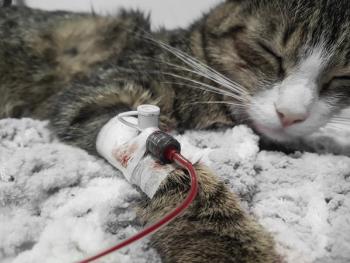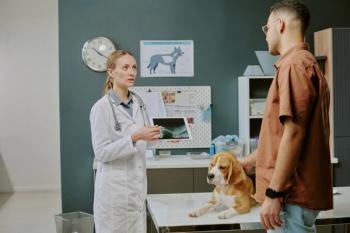
- dvm360 January 2022
- Volume 53
- Issue 1
Patient handoffs: Improve team dynamics and hospital culture through collaboration

An expert discusses best practices in patient handoffs.
Content submitted by BluePearl, a dvm360 Strategic Alliance Partner
Patient handoff is the process of transferring responsibility for the care of a patient from one caregiver to another. During patient handoffs, or rounds, all relevant historical and clinical patient information must be conveyed accurately. If important information is omitted or misunderstood, increased risk to patient safety and decreased quality of care may result. Studies in human medicine show that communication errors during patient handoffs are frequent and patients commonly experience harm as a result.1 Creation and adoption of best practice recommendations for patient handoff in human medicine, such as standardized handoff formats and closed loop communication, have led to decreased medical error rates and improved patient safety.2
Though miscommunication during patient handoff has not been systematically evaluated in veterinary medicine, it is likely that the handoff process confers similar safety risks to patients. Despite compelling data in human medicine demonstrating the benefit of using handoff best practices, guidelines for handoff do not yet exist in veterinary medicine. Patient handoffs occur almost every day in veterinary practices. This creates the opportunity to apply the learnings and best practices from human medicine to veterinary settings.
Due to improved patient outcomes, standardized handoff tools are used in human hospitals regularly. However, the path to widespread adoption was not without hurdles. Many clinicians believed that instituting standard handoff formats was unnecessary and that their rounds were already thorough enough. Some believed that changes to rounds would lead to inefficiencies and that they lacked the time to incorporate this process. But as more and more evidence mounted over time, there was no denying that standardized, multidisciplinary rounds led to better patient care, improved team dynamics, and increased professional satisfaction.
Patient safety
Approximately two-thirds of “never events” in human medicine occur as the result of communication failures.1 Successful patient handoffs require timely, efficient, and complete communication between caregivers. As the complexity of care being delivered increases, more details about patient history, diagnostic test results, and response to treatment must be conveyed when transferring care to a new doctor or nurse.
Forgetting to mention a patient’s preexisting conditions or current medications can result in significant morbidity and mortality. For example, forgetting to convey that a patient is on steroids for atopy at the time of admission to the hospital could result in life-threatening complications if the patient subsequently receives nonsteroidal anti-inflammatory drugs for pain management following surgery. Some clinicians feel that such mix-ups would never happen to them, but the reality is that they do—and they can have serious consequences for patients. In human medicine, use of a standardized format for patient handoff for every patient, every time, has dramatically reduced the number of medical errors and adverse events secondary to communication errors during patient handoff.2
Implementing I-PASS
The I-PASS Patient Handoff Bundle is an evidence-based set of handoff interventions consisting of a standardized patient handoff tool and structured handoff and communication training. In the original study, implementation of the I-PASS bundle decreased adverse events by 23% without increasing the total duration of rounds.1
The I-PASS tool is used for reference during verbal handoff to help providers ensure that all-important details about the patient’s history, current status, diagnostic test results, and treatment plan are discussed. Verbal rounds should also be accompanied by a written document that follows the I-PASS tool format and includes more detailed information about the patient’s case.
The I-PASS format also includes a summary, or “synthesis,” component that may be the most important. The synthesis provides an opportunity for caregivers to confirm they have a “shared mental model” of the patient that answers the question “Did I correctly understand what I heard?”
Use of the I-PASS handoff bundle is a way to ensure that the team walks away from rounds with a better understanding of the patient, the goals for the day, and the contingency plans when changes in patient status occur. I-PASS stands for:
- I: illness severity (unstable, watcher, stable)
- P: patient summary (signalment, brief overview or prior history and medications, brief history leading up to presentation, review of diagnostics, treatment, and response to treatment)
- A: action list (what needs to be done today)
- S: situation awareness and contingency plan (if-then statements)
- S: synthesis by receiver (confirmation of summary by the receiving clinician and opportunity for questions)
I-PASS is only one of several structured patient handoff tools used in human medicine. Others include SBAR, SIGNOUT, and MIST.
Culture and teamwork
In addition to reducing patient safety errors and improving overall medical quality, patient handoff is also an opportunity to improve team dynamics and hospital culture through collaboration.2
“Since implementing daily multidisciplinary handoff rounds, we have discovered opportunities for improvement in patient care that were not previously recognized,” said Laura Roy-Eitner, DVM, medical director and emergency clinician at BluePearl Pet Hospital in Christiana, Delaware. “The open forum of rounds provided an opportunity to identify these areas for growth and formulate corrective plans as a cohesive team. The patient handoff process in our hospital provides our clinicians with greater understanding of goals for patient care, resulting in increased confidence in decision-making. This has led to significant improvements in interdepartmental communication and professional satisfaction, particularly for our overnight clinicians.”
Using a standard handoff format and involving nursing teams in handoff rounds was shown to significantly and positively affect collaboration and teamwork in one human teaching hospital.3 Using patient handoff tools should be considered a new way to improve teamwork and learning in veterinary settings as well.
Summary
Instituting a standardized patient handoff format in daily rounds is likely to improve patient safety and medical quality. In addition, handoff rounds create an opportunity for building stronger and more satisfied teams. Emotions are high, and the environment is stressful in most veterinary practices. These factors contribute to attrition and burnout of veterinary professionals. It is important to focus our efforts on creating a culture of collaboration and support so that clinicians can continue to provide care for patients in need.
References
- Starmer AJ, Spector ND, Srivastava R, et al; I-PASS Study Group. Changes in medical errors after implementation of a handoff program. N Engl J Med. 2014;371(19):1803-1812. doi:10.1056/ NEJMsa1405556
- Joint Commission on Accreditation of Healthcare Organizations. Sentinel event alert. Accessed Oct 2021. https:// www.jointcommission.org/-/media/tjc/ documents/resources/patient-safetytopics/sentinel-event/sea_58_hand_off_ comms_9_6_17_final_(1).pdf
- Cao V, Tan LD, Horn F, et al. Patientcentered structured interdisciplinary bedside rounds in the medical ICU. Crit Care Med. 2018:46(1):85-92. doi:10.1097/ CCM.0000000000002807
Articles in this issue
almost 4 years ago
Convert an existing building into a veterinary hospitalalmost 4 years ago
Diabetes management: Can we do a better job?almost 4 years ago
Key advances in veterinary oncologyalmost 4 years ago
The Dilemma: The referencealmost 4 years ago
Commentary: How do you define success?almost 4 years ago
“I” message vs “You” messagealmost 4 years ago
Multicancer detection in dogs with cell-free DNAalmost 4 years ago
How One Health is forging a better futurealmost 4 years ago
To treat or not to treat? Navigating the gray area of Cushing syndromeabout 4 years ago
Work-life balance in veterinary medicine: Findings and solutionsNewsletter
From exam room tips to practice management insights, get trusted veterinary news delivered straight to your inbox—subscribe to dvm360.




